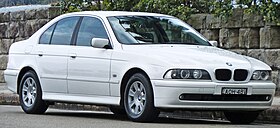| BMW 5 Series (E39) | |
|---|---|
 Facelift BMW 525i sedan (E39, Australia) | |
| Overview | |
| Manufacturer | BMW |
| Model code | E39 |
| Production | September 1995 – May 2004 |
| Model years | 1997 – 2003 |
| Assembly | Germany: Dingolfing |
| Designer | Joji Nagashima (1992) |
| Body and chassis | |
| Class | Executive car (E)[1] |
| Body style | 4-door sedan 5-door wagon (Touring) |
| Layout | FR layout |
| Related | BMW 7 Series (E38) |
| Powertrain | |
| Engine | |
| Transmission | |
| Dimensions | |
| Wheelbase | 2,830 mm (111.4 in) |
| Length | 4,775–4,805 mm (188.0–189.2 in)[2][3] |
| Width | 1,800 mm (70.9 in) |
| Height | 1,435–1,445 mm (56.5–56.9 in)[2][3] |
| Curb weight | 1,685–1,845 kg (3,715–4,068 lb)[4][5] |
| Chronology | |
| Predecessor | BMW 5 Series (E34) |
| Successor | BMW 5 Series (E60) |
The BMW E39 is the fourth generation of the BMW 5 Series range of executive cars, which was manufactured from 1995 to 2004. It was launched in the saloon body style, with the station wagon body style (marketed as "Touring") introduced in 1996. The E39 was replaced by the E60 5 Series in 2003, however E39 Touring models remained in production until May 2004.[6][7]
The proportion of chassis components using aluminium significantly increased for the E39, and it was the first 5 Series to use aluminium for all major components in the front suspension or any in the rear. It was also the first 5 Series where a four-cylinder diesel engine was available. Rack and pinion steering was used for four- and six-cylinder models, the first time that a 5 Series has used this steering system in significant volumes. Unlike its E34 predecessor and E60 successor, the E39 was not available with all-wheel drive.
The high performance E39 M5 saloon was introduced in 1998, powered by a 4.9 L (302 cu in) DOHC V8 engine. It was the first M5 model to be powered by a V8 engine.
- ^ "1995 BMW 523i Steptronic specifications". www.automobile-catalog.com. Retrieved 7 December 2017.
- ^ a b "Specifications for BMW 523i E39 Sedan (1995-1998)". www.bmwheaven.com. Retrieved 26 May 2019.
- ^ a b "Specifications for BMW 540i E39 LCI Touring (2000-2005)". www.bmwheaven.com. Retrieved 26 May 2019.
- ^ "2002 BMW 535i E39 car specifications, auto technical data - performance, fuel economy, emissions, dimensions 104071". www.carfolio.com. Retrieved 26 May 2019.
- ^ "2002 BMW 540i Touring Automatic E39 car specifications, auto technical data - performance, fuel economy, emissions, dimensions 96184". www.carfolio.com. Retrieved 26 May 2019.
- ^ "BMW 5er touring (E39)" [BMW 5 Series touring (E39)]. bmw-grouparchiv.de (in German). BMW AG. Retrieved 21 August 2019.
- ^ Annual Report 2004 (PDF). Bayerische Motoren Werke Aktiengesellschaft. p. 13. Retrieved 24 April 2017.